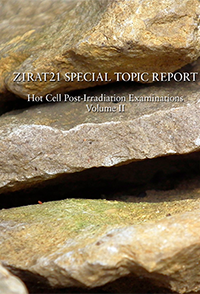
Hot Cell Post-Irradiation Examinations Volume II
(ZIRAT21/IZNA16)
Maintaining and improving reliability of fuel and structural components requires an understanding of their behaviour in reactor and the mechanisms that have been observed to cause failures. A key factor in improving reliability is the identification of the cause or causes of failure. Such information, in turn, requires the examination and analysis of irradiated fuel (including bundle hardware) and structural components at reactor sites (poolside examinations), in hot cells and in related laboratories. Thus, to make progress toward ultra-high reliability fuel and to reduce the potential for fuel failure, it is imperative to examine both failed and non-failed (reference) fuel.
Post-irradiation examinations (PIE) provide fuel vendors and nuclear utilities with data on how newly developed or established materials withstand normal operating conditions in new environments. Post-irradiation examinations are largely carried out at a Hot Cell Laboratory where irradiated fuel rods and other hardware can be received, handled, examined, and tested. The investigation results provide information for fuel and component improvement and, thereby, can potentially enhance operating efficiency and reliability.
- Section 1 provide an overview about the status of post-irradiation examination (PIE) and inspection techniques for nuclear fuel and other zirconium alloy components used in CANDU reactors and their applications for analysis of materials behaviour in a CANDU reactor core.
- Section 2 discusses these techniques along with real world examples of in-reactor microstructural changes and impact on material behaviour.
- Section 3 provides information on PIE capabilities of some of the major hot cell facilities. This information will be useful for utility engineers when they need to have PIE performed on failed nuclear fuel or other components.











